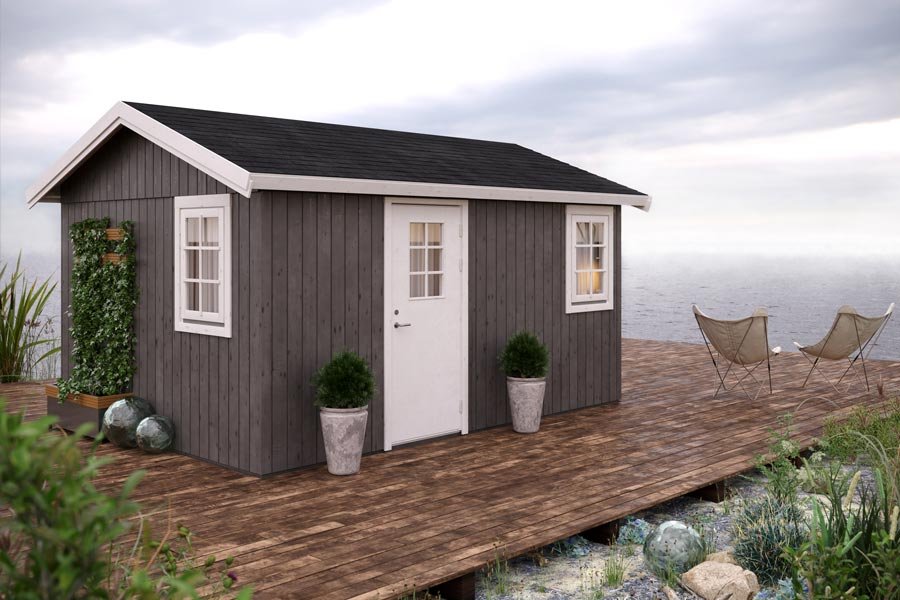
by Mark Bailey | Feb 14, 2018 | GardenLife Magazine

Your rain garden guide – construction, location, plants and more
We’ve talked about climate change and garden design on this blog before, and given pointers on how it might impact your garden. So now we’re going to continue on the theme, and discuss how we (or our gardens) could deal with a whole lot more rain.
For some of us, it will come into the form of heat and drought during the summers and torrentially wet winters with storms and flooding. For others, it will mean warmer, wetter weather all year round.
Either way, gardeners, wildlife watchers, water companies, and others are adopting the idea of the rain garden as a solution to all this excess water.
What is a rain garden?
Put simply, rain gardens are a sunken dip with plants and vegetation which collect run-off water, from your roof, patio, other hard surfaces, or overflow pipes. Crucially, they do this before the run-off water overwhelms your local drainage systems and leads to flooding.
They basically mimic the ups and downs of the natural landscape (before we covered it over with paving, roads, patios, car parks, patios!) and have plants that don’t mind their roots being waterlogged for a few days at a time.
The advantages of having a rain garden?

As you trudge through your boggy garden after a week of rain, you may feel you already have a rain garden. But planning a rain garden could transform a mudbath into something wonderful – a view to savour from your home or a garden room.
The great thing about a rain gardens is, they’re relatively easy to plant, and even easier to maintain. And in both respects, they’re a simple alternative to installing a garden pond (though it’s not actually a case of either/or, as they can look brilliant in combination).
Rain gardens can absorb up to 30% more water than a lawn, and don’t need mowing. And by reducing the risk of flooding, they also reduce the pollution risks associated with flooding (because run-off washes oil, metals and pollutants from roads etc into watercourses).
They can also be used to harvest rainwater, helping to reduce the effects of drought and cut down on the need for watering (another way in which they cut down on labour).
And, last but not least, it turns out there’s a huge choice of herbaceous and perennial plants that love to have a soggy bottom (see below). And also that many of these rain-tolerant plants are attractive to birds, butterflies, bees and other wildlife. So add biodiversity to the list of benefits.
What’s the best location for a rain garden?
Before you start digging a rain garden into a lawn or flowerbed, it’s important you know if and where any subterranean cables or pipes for gas and electricity etc. are in your garden. It’s best to avoid digging into them!
Secondly, it’s recommended not to site a rain garden within (3m) 10ft of a property – you don’t want water to do awful things to your foundations.
Rain gardens are not recommended for slopes with an incline of more than 10%. And don’t put one too close to a garden room or office in case there is overflow into the base area for the building.
Other than that, the main advice for positioning a rain garden is that it should be in full or partial sunlight (otherwise you may just end up with a swamp). And if you already have a natural dip in your garden, that could be a good starting point.
For more detailed advice about location and construction have a look through this user-friendly guide.
What’s the best soil for a rain garden?

The Royal Horticultural Society recommends a simple test to find out if your soil is suitable for a rain garden.
You dig a hole about 25cm (10 in) deep and fill it with water. Wait for it to drain away, then fill it up again, and watch how long it takes to drain. The RHS say an ideal rain garden site drains at a minimum of 1.25cm (0.5in) an hour. It should also be fine with absorption rates of up to 5cm (2in) an hour.
If it takes longer, your soil is not suitable – you might have a heavy clay soil, for example, or a high water table.
There are other variations on this test online, but the general idea is similar.
How big should a rain garden be?
It depends on the size of your garden overall, the level of drainage, climate, and the size of your run-off point (likely your roof).
The general rule of thumb is ‘the bigger the better’, especially since smaller ones are more prone to water logging and less able to prevent large run-off into drains etc. Again, the RHS website has some practical advice.
What plants are recommended for a rain garden?

There’s a surprisingly wide choice of easy-to-maintain plants – herbaceous perennials, in particular – that thrive in wet ground. Generally, you want to plant a broad variety of species with strong and dense roots to ensure absorption of water.
The main plants to avoid are Mediterranean species such as lavender whose roots are water-averse, or plants such as azalea which are prone to root rot.
The London Wetland Centre website has some excellent ideas for planting, and there are extensive lists of plant recommendations on the RHS website.

Wildflowers can also grow well around the edge of rain garden, and can help attract wildlife. There are some good ideas for wet soil wildflowers available here.
With these lists in hand, you’re well on the way to a climate-adapted garden that will not only be better for the environment than flooded hard surfaces or a boggy lawn, it will also be less stressful and look better – whether you’re enjoying the view from your kitchen window or relaxing in a garden room.
Too much rain? Not a problem. For the gardener at least.

by Mark Bailey | Jan 10, 2018 | GardenLife Magazine

Hygge garden design? The lagom garden concept? Transform your garden in 2018
No, they’re not names of shrubs, but Scandinavian lifestyle trends. Hygge’s probably the best known but forecasters say that lagom, ikigai or even còsagach could well displace it in 2018.
Because each word encompasses a concept that crosses over anything from wellbeing to design, to eating and drinking, to how you spend your free time, they really could transform your life as well as your home or garden.
So, we’ll do a whistle-stop guide to what each concept means, and then we’ll give you ideas for incorporating them into your own garden.
Hygge garden design?
Hygge is Danish, and it’s all about the idea of coziness, conviviality and being comfortable in the moment. It’s opened a way for a range of self-indulgences, from drinking hot chocolate with friends, to homes filled with cashmere throws and a wardrobe to match. Being Scandinavian, there’s a sense of moderation and good taste around it, though – think contentment rather than mad-for-it hedonism.

Hygge’s easy to visualise inside a café or country pub, but do you get hygge into a British garden – particularly as the chill winds of winter blast through the gaps in your fence?
Think garden buildings. Natural timber, well-insulated from storms and winds, a snug space away from household chores and the stresses of work – a timber cabin could be the perfect hygge addition to your life.

A great example of hygge cabins, on an affordable budget, is our Claudia pavilion – with windows on three sides to let in natural light; dense Nordic timber to keep out the chills; and a space that’s cozy without being claustrophobic.

Another perfect retreat is Melanie – a clever shape that fits into a corner in your garden, with light coming in on three sides – but not Arctic-style draughts, thanks to double glazing. It comes in a choice of two sizes, so you can choose how many people who want to get hygge with. The larger version of Melanie (9.6 sq m) has 44mm wall timbers – idea for keep cosy whatever the winter weather.

And then there’s Veronica. With an octagonal design, it is reminiscent of a sauna hut, but the double windows allow in more light – giving you a connection to the outdoors, and making it great for summer use as well as a space to hide away in during winter. Like Claudia, it’s compact, so it won’t eat up too much of your lawn or borders, but with 6.7 sq m of space, you’re still have space to lounge over your fika (Swedish for a coffee with a cake or pastry and preferably a chat as well).
If you want to go full tilt for the sauna vibe, how about a Scandinavian barbecue hut like our Eva design (customer photo just below), with bench seating around the edge, a BBQ grill and smoke extraction hood, and 44mm insulated walls to help keep everyone toasty all year-round?
The lagom garden concept?
Before getting too wholeheartedly into a daily fika habit, it’s worth thinking about lagom, another lifestyle trend for 2018. Lagom is used in many different contexts, from eating to ways of doing business to eating to lifestyle choices, so there’s not one-translation-fits-all. The general idea is “everything in moderation”, avoiding excess in anything from work to play to diet to being too ‘Me, me, me”.
So, how does this translate into garden design and garden buildings? Rather than letting work, commuting or retail consume your 2018, how about finding a garden refuge where you can be healthy, happy and content – whether spending more time with family or friends or taking up a new hobby?

Another element of lagom to incorporate in your garden is the design aesthetic. For example, the classic stripped-back Scandinavian colour palette of chalky matte paint, milky whites, blue-greys, and stone, spiced up with small splashes of dark red, brick or yellow, is very lagom, and would work beautifully with any of these garden buildings – both exterior and interior.

We also sell a selection of easy-to-build models whose design is Nordic-influenced. Hedwig is a Quick Fit design inspired by Swedish summer houses – simple, sturdily built, pastoral. Add some red paint on the exterior and you could be in a Scandinavian forest or island.
For a more urban and contemporary aesthetic, take a look at Ly. Spacious (with 10.2 sqm of floor space, or 13.6 sqm of space if you go for the largest model) but still Nordic-influenced in its functionality, comfort and pared-back aesthetic. It makes a great office or workroom – the placement of the windows means you get plenty of light without being on display.
An ikigai garden?
Another trend for 2018 is the Japanese idea of ikigai. This is less about interior design, more about how you live your-life. As with lagom, it’s difficult to find a direct translation, but suggestions range from ‘self-realisation’ to ‘what gets you out of bed in the morning’. It’s about what gives meaning to your life, and according to the Wikipedia guide to ikigai, this could be anything from work to having children to hobbies.
To our minds, there’s no doubt about it: ikigai means having a shed. Or man/woman-den, garden building, workroom – call it what you will. You could use it as creative studio, gym, brewing shed, games room, or a garden office to start the business you’ve long daydreamed about.

A timber cabin like Ines can be perfect here – it’s an elegant design, with clean lines and no over-the-top design details, and we’ve heard of people using it as anything from an extra living room or breakfast room, to a garden gym or yoga retreat. With 44mm walls and double doors that open wide, it can be as snug or airy as you wish.
Getting “còsagach” in your garden?
Our final word for 2018 is còsagach. Announcing it as a lifestyle trend for the year, VisitScotland translated it as snug or sheltered, and encouraged businesses to create environments that “induce a feeling of warmth or cosiness”.

Unfortunately, the choice of còsagach also reminded us of the dangers of adopting hard-to-translate foreign-language words as lifestyle themes. VisitScotland’s advice aroused a backlash from Gaelic speakers who said còsagach in fact means ‘a damp mossy place’ or ‘a wee nook or hole such as very small creatures might live in’ – one person mentioned woodlice.
Not something to aim for when you’re choosing a garden building; best stick with hygge garden design or the lagom garden concept!

by Mark Bailey | Dec 15, 2017 | GardenLife Magazine, How to guide

Garden security: tips for securing gardens and outbuildings
Most of us are fairly clued up about the security of our homes – with alarms, multiple locks, movement sensors and security lights being commonplace. As a result, crime stats show you were almost four times less likely to be burgled in 2017 than in 1995!
But whilst we’re impressively canny about protecting our homes, too many of us are still prone to neglect the outside of our homes, with little or no thought to garden security. There’s a garden theft around every 8 minutes in the UK and the financial toll can be heavy – especially if you have expensive garden furniture or tools, or a garden office or workshop.
According to one insurance company the most commonly stolen items are bicycles and power tools, but also vulnerable are garden furniture, ornaments, plants and oil tanks. Thefts reported have even included a window, turf, fireworks, and gold bullion!
So here are some easy and accessible garden security tips on how to make your garden and outbuildings more crime-proof.
Natural ways to enhance garden security

If you don’t fancy splashing out on high maintenance gadgetry, adopt a more horticultural security approach – planting prickly ‘defensive’ plants and shrubs like pyracantha, berberis or a native evergreen holly (there’s a good list of thorny hedges on the Hedges Direct website and the Thompson Morgan site has some good suggestions too).
These can make uninvited visitors life decidedly trickier and halt them in their tracks or bring them to your attention (perhaps through their exclamations of pain or annoyance), whilst also looking great. As an added bonus, the berries on shrubs like pyracantha and berberis can also be wildlife-friendly (the RSPB has more useful advice on bird-friendly berries if you are interested).
Spreading gravel or creating a gravel path also makes an inconspicuous approach impossible, while installing wooden or even spiked trellises on top of your walls can deter entry and improve garden security. You could even install planters down your walls and thorny climbing roses or spiky vines to stop people clambering over them. During the day you can enjoy looking at the planting whilst easily avoiding the prickles and thorns, but at night (to unsuspecting thieves) the plants can help to secure gardens and outbuildings.
Improve garden security with structure

Making your garden and its contents more secure need not even require money or specialist equipment and gadgets – the layout itself can help improve overall garden security.
Simple things like keeping hedges and shrubbery low to starve would-be intruders of hiding spots or cover can go a long way. Saga suggests limiting them to around 1m high. This keeps them hard to hide behind, but still tall enough to break up your garden or create the ‘rooms’ so beloved of garden designers.
Also useful is to make sure your house has an unobstructed view of your outbuilding, workshop or summer house – this makes sloping or slightly sunken plots perfect. It’s also wise to locate your outbuildings with the doors facing your main view of the garden with a clear line of site.
What tech can help increase garden security?
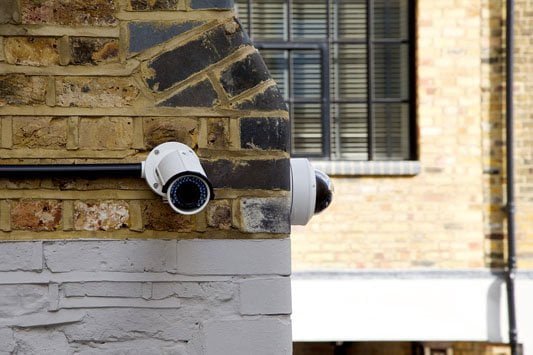
The options here can start from £20 or less – with simple security lights or battery-operated shed alarms. You can get a good idea of the options at Maplins or other electronics or DIY/home stores.
Heading up the technology scale, motion-sensing floodlights are popular for improving garden security and can come in at well under £100. That being said, if you have a pet, the strobe-like lighting that can ensue each time it goes outside can get tiresome!
Lights which only come on certain times (e.g. you can programme them to work from dusk till dawn) are also available. You can find a solid selection of outside security lights at sites such as Lighting Direct and The Lighting Superstore.
For garden owners who are more anxious or have more to protect, web-linked CCTV cameras that can stream real-time full HD video to your phone or computer can come in at under £200, although installing them might require a tech-savvy helper and a speedy internet connection.
And although likely the most expensive measure, a garden alarm can both catch and deter intruders – Ultra Secure Direct has a good selection of specialist wireless garden alarm systems (including a telephone and text message alarm disguised as a bird nesting box).
Secure garden outbuildings

If it’s the contents of your shed or office you’re worried about, you might want to upgrade to a more security-conscious garden building. Having a building with sturdy cylinder locks, laminated doors, double glazed windows and 28 – 70mm thick timber walls can all provide added protection, and keep out opportunistic visitors. And into the bargain, you get a warmer, better insulated space for working, entertaining or relaxing.
Does home insurance cover garden security?
Taking out an insurance policy on the contents of your garden – or just checking if your current insurance covers summer houses and garden outbuildings – can also go some way to give you peace of mind should the worst happen. It is worth checking what your current insurer covers; it’s surprising how many policies don’t cover theft from the garden or an outbuilding.
The common sense approach

If it ain’t broke, don’t fix it – if you’re not in the mood to make major changes, simply buying an additional door or window lock will boost your security. As for garden ornaments and statues, well, actually you could fix them – anchors can help make sure no one makes off with them.
Even obvious things such as making sure side or back gates have locks, and then remembering to use them, can make all the difference. Making sure to put garden equipment or furniture back in their resting places can also prevent opportunistic passers-by from making a quick buck at your plot’s expense. Sometimes it’s just the little things that can help improve your garden security and prevent a theft.
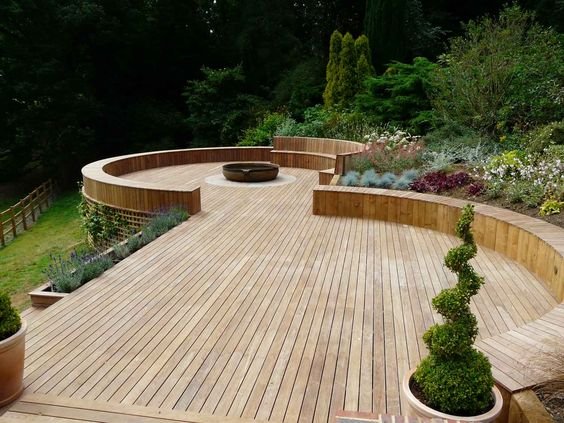
by Mark Bailey | Nov 30, 2017 | GardenLife Magazine, How to guide
Put off garden decking ideas by 1990s TV garden makeovers? Don’t be, it offers unique and creative design possibilities, many of which you won’t have ever considered.

Garden decking has become a victim of its own success over the past few years – the subject of so many late 1990s TV garden makeovers that garden designers adopted a sneer whenever they heard the word. And that’s a huge shame, because decking can be used to create brilliant garden designs – practical, affordable, creative and interesting.
With winter greatly reducing the number of other parts of the garden requiring attention, now is a great time to think about decking. Indeed, looking out the window at an under-used muddy back garden could well provide the incentive to use decking to create a more inviting space. Just make sure you wait until the rain stops before installing it – otherwise you may face an epic battle with mud and damp wood.
Here are some ways you can use traditional garden decking to give your plot more interest and functionality.
The classic garden decking BBQ and patio area

This is the best-known use of decking, so beloved of the TV makeovers. There it was used because it was quick, cheap and cheerful – easier to accomplish in two days than actually growing something.
Decking is certainly easier and more flexible than paving or concrete. And it’s ideal for creating a level surface in a sloping garden.
But decking is not just a matter of easy answers. Pinterest has beautiful ideas for using decking imaginatively, and garden writer Anna Pavord recommends getting creative with the colours of decking – looking at shades such as “watered-down green”, soft grey or “patchy olive green”, set off by contrasting flowers in pots. Using decking diagonally or at different angles can also look brilliant.
Vertical garden decking ideas and zoning
Decking need not be limited to the ground – incorporating it vertically into your garden walls can make urban gardens feel more natural, and softer on the eye. And different woods can create different moods – for example, cedar can introduce a Japanese feel.
Decking – horizontal and/ or vertical – can also be used to section off a particular area of your garden or patio, for example to create a raised lounging, play or al-fresco dining area.

Lighting can be integrated into floors and walls – for example, uplighters put into paths and patios for security; downlighters put into decking walls; or LED strips hidden under decking edges. You’ll find some tips and ideas for this at www.exteriorlightsuk.co.uk and www.philips.co.uk.
Speakers can also be set into the woodwork, as can sofas and benches. Planters or trellises can also be incorporated into vertical or horizontal decking designs if you want to break up the wood with some greenery.
Decking or wooden rails can also be used to create a roofed area or pergola, offering some shade and creating beautiful shadow effects. The trick here (as with decking walls) is to think about the spacing of the wood – too close together and the area may look like a sauna.
Garden decking foundations and structures

At a practical level, decking can be invaluable if you’re thinking about installing a garden building. Using it around and underneath garden sheds, storages or summer houses will not only raise them and create a vantage point, it’ll also protect against damp and insects.
Here too, you can be creative, using colour, material and design to contrast or blend with anything from a garden workroom to a gazebo.

You can also combine decking with other structures – from wooden storage units to raised beds or wall-mounted planters – to create interesting textures and surfaces.
Garden paths made from decking?
One reason why decking got a bad name is that people simply ripped out whole lawns or borders and covered them over with an expanse of monotone wood. It’s not just the aesthetic effect people bemoan here; there are warnings that covering over gardens with paving or decking can exacerbate flooding or remove wildlife habitats [PDF].

Buck decking can be used more sparingly to make paths, either raised or flush with the lawn. Not only does this prevent a well-used path across a lawn from becoming a bog, it also create a pleasing ‘journey’ effect that breaks up a space, and is a nice modern substitute for stone or gravel.
Different types of decking materials
The cheapest decking option is usually a pressure-treated softwood, such as pine, available from around £25 sq m. Cedar and redwood are also popular – though more expensive softwoods, with some natural protection against rot and insects. These are usually somewhere from £25/m².
Hardwoods such as oak or teak, although more expensive, are more durable and aesthetic. When buying timber, look for Timber Decking Association-approved wood which tells you it’s of a decent standard.
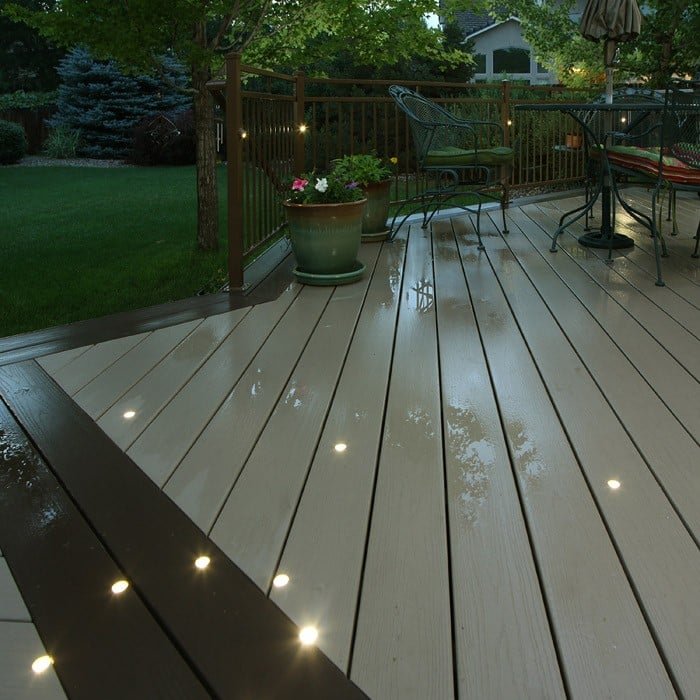
And then there is composite wood decking – a mixture of wood particles and plastic – which is weather-resistant and hard-wearing but doesn’t look like real timber. There’s more advice about choosing your decking material available on this website.
DIY garden decking ideas – the practicalities

In terms of installation, there are plenty of basic DIY guides online. Useful ones include:
Larger or sloping areas will likely require professional installation – setting you back in the region of £500 or thereabouts – and will probably require planning permission if above 30 cm high. It’s a long-term investment though, given that you maybe able to get 3 decades out of good quality decking.
With all wooden decking, there are practicalities to think about. If neglected, a decking path may turn into an ice rink in the winter months, fitting it with chicken wire could be useful. There are also anti-slip solutions from providers such as Gripsure and Deckwright, which can prevent damp decking from turning into a slippery, slimy health and safety hazard, and are readily available in DIY chains.
And finally, on the maintenance front, all types of timber decking will need to be cleaned, sanded and resealed every year or two. For basic cleaning – preventing or dealing with the dreaded algae – there are plenty of cleaning products available in DIY stores. There are some eco-friendly cleaning recommendations on the Amatuer Gardener website.

by Mark Bailey | Oct 19, 2017 | GardenLife Magazine
Too much stuff? What you need are some helpful ideas for self storage solutions and other alternatives.

Lots of stuff; but not lots of space. It’s a growing problem for many of us, as modern flats and houses get smaller, and the number of things we accumulate grows ever bigger.
And however good our intentions to de-clutter and get rid of possessions that don’t ‘spark joy’, it’s difficult in practice. It seems heartless to throw away children’s artwork and old wedding gifts; and downright stupid to rid yourself of all your winter clothes because you don’t have enough hanging space.
So, for most of us de-cluttering is more about finding cost-effective self storage solutions than divesting ourselves of the stuff we own. But what are the best self storage solutions, and what are the realistic alternatives?
Self storage solutions: size, cost and extras

Self storage units are long favoured by students, urban renters with a lack of space, and people moving house. They’re affordable, flexible, and increasingly accessible. And certainly more manageable for most people’s budgets than renting or buying somewhere bigger to live.
In the UK, self storage units tend to range from a tight 2.25 sq m (the size of a small garden shed) to around 15 sq m (roughly the size of a double garage). If you’re renting on a short-term basis, expect to pay upwards of £10 a week for the smallest units, rising to £50-plus a week for 15 sq m. But price will vary significantly depending on location, size, length of contract, and the type of unit you want.
Many self storage units offer additional features such as 24-hour access, van hire, air conditioning, lighting, forklifts for heavier items, and CCTV – expect to pay extra for these. Committing to a longer contract can reduce the price per week, and it’s worth shopping around.
There are plenty of online storage comparison sites, which can tell you your local options and give ballpark prices. Compare The Storage and Storage Price Comparison are both useful here.
And if you want generic advice about using the best self storage solutions there’s good advice and FAQs on the Self Storage Association website.
Self storage isn’t a solution for everyone
Self storage is burgeoning, but there are downsides too. Location, for a start.
Given that self-storage units are usually contained in vast warehouses, you may have to drive to an out-of-town industrial park to access your stuff. Problematic for rural or urban dwellers, or those without a car.
In addition, the interiors can be labyrinthine, confusing or a depressing place to spend a Sunday morning, and the quality and convenience of the storage can vary widely.
So, on what’s on the menu if you want to keep your things closer to home?
A home extension instead of self storage?

If you can’t shrink your stuff, you need to grow your space. Option one is a home extension. You probably know all the pros here – adding value to your home, getting exactly the storage and living space that you want, in a style that fits your taste, and makes the most of modern building efficiency and insulation.
That’s the upside. You’re probably just as familiar with the cons – the upheaval, the planning processes involved. And the costs.
As with most self storage solutions, the costs of an extension will depend on location, size, materials, single-storey or double-storey etc. The rough rule of thumb for extensions used to be around £1,000 per sq m for a single-storey extension, but the Design For Me website (which has a useful price estimation tool for extensions) suggests more like £1,200-£2,000 per sq m.
And that doesn’t include professional fees, fittings, unexpected costs and overruns, and all the rest.
Garden storage solutions – easier on the pocket and your patience
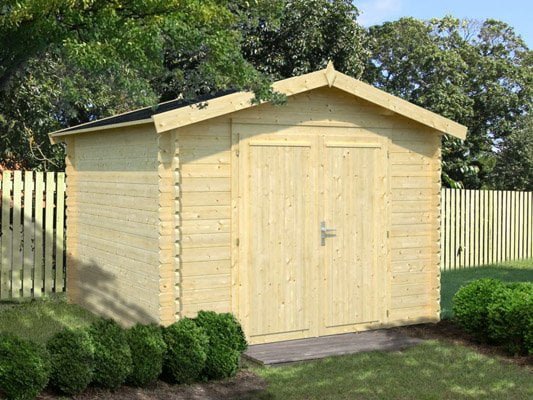
Option two for extending your space is to think about garden sheds, workrooms, garages and offices. They’re a much cheaper and more flexible alternative to an extension, and may cut out the need to go through the planning permission process. And you still get to store your stuff securely and close at hand.
If your idea of a garden building is still a one-person potting shed, it’s time for a rethink. You can now find attractive garden buildings for storage (or living, working or entertaining) measuring anything from 4 sq m to a whopping 25 or 30 sq m, in any style from Dutch barn to contemporary urban garden office. They are all designed to be built by those with even the very basic DIY skills too.
Price-wise the garden building option comes out well when compared with both long-term self storage and home extensions.
Take self storage solutions. Let’s say you pay £50 a week for 15 sq m of self-storage, or upwards of £2500 a year. And then let’s say you look at a solid timber garage or garden workroom at around £4,000, with 19 or 20 sq m of space – not only has it paid for itself after 2-3 years, but you also have a flexible asset in walking distance of your own door.
If it has outlived its usefulness as a storage space, some minor fixes can turn it into an outdoor office, children’s den, extra living room or whatever else takes your fancy.
What to look for
If you’re going to store your precious possessions in a timber garden building, you want them to stay safe, usable and in great condition.
So, whilst saving money (compared to an extension or a self storage solution) may be the motivator, don’t cut cut your budget at the expense of durability, weather-proofing and security:
- Buying a cabin with thicker chalet-cut tongue and groove cladding will provide a more robust solution than cheaper sheds with overlap cladding
- Slow-grown timber is denser and more robust than quicker-grown timber. Look for wood grown in Nordic countries, since the denser grain will make it less likely to warp, twist or split, and will provide better insulation.
- Features such as toughened glass and secure locks will help protect your possessions from unwelcome visitors.
- Pay attention to suppliers’ instructions around wood preservation treatments, and the base to build your cabin on. This will help prevent damp, mould and other weather-related problems.
- Check to see if your timber garage or garden room can be dip treated before delivery to better protect it.
With a wide choice of self storage solutions, a home extension, or even a new garden room that you can build yourself, there should be something to match your budget and needs.

by Mark Bailey | Sep 21, 2017 | GardenLife Magazine, How to guide

Smartphones and gardening apps are not the first thing to spring to mind when you’re thinking about good tools for the garden. But modern technology has made gardening easier and more accessible than ever.
Answers to gardening problems or tips which once required a trip to the library or garden centre are now being carried around in our pockets, just a few taps away.
Here are a few of our favourite gardening apps to fuel your passion for all things green or improve your own patch.
The best garden planning app

Garden Plan Pro – iOS, £7.99
Many of us have good intentions about growing our own fruit and veg or applying for an allotment, and then don’t quite get around to it. The Garden Plan Pro app could be the jump-start you need to get planning, digging, sowing and harvesting.
Don’t be put off by ‘Pro’ in the title – it’s aimed at beginners and allows you to create designs and your own ‘3D’ models of your ideal garden to see how it could all piece together – even telling you the ideal spacing for plants, and what plants would grow well next to each other.
What’s more, if you enter your location it will give you articles/tips etc for your own climate, as well as send you weather updates (eg a warning of frost on its way), and planting or harvesting reminders.
It’s certainly not the only app of its type on the market, but it’s a practical and user-friendly starting place.
The best garden scheduling app

Gardenate – iOS and Android, 55p
Timing can be everything in gardening, especially when it comes to planting and harvesting, and it’s one of the most daunting aspects for the beginner.
The 55p Gardenate app helps with this, by making a calendar on your phone with all the key timings – fertilising, feeding and so on – for just about any vegetable or herb you can think of. It also offers suggestions on the perfect plants to invest in depending on your climate and time of year.
The app covers Australia, Canada, New Zealand, South Africa and the USA, as well as the UK, so it’s quite generalised. For the UK, it has just two zones – cool/temperate for the north and west, and warm/temperate for the south and east – so the advice is not localised enough for some people’s taste. But it’s a good general guide, with a simple and lucid layout that’s intuitive to use.
Best gardening apps for identifying plants and weeds

B&Q Gardens App – iOS and Android, free
Not sure whether the thriving plants in your garden should be there or not? The B&Q Gardens app has a tool to help you identify common weeds and learn how to deal with them (using products from B&Q, of course).
There’s also an image recognition tool allowing you to take pictures of flowers you like (or that you have in your garden and don’t know what to do with), and identify similar ones in the B&Q range.
If you don’t find what you’re looking for on the B&Q app, there are plenty of other free or paid-for apps that will help you identify a mystery plant by uploading a photo.

Garden Answers Plant Identifier app – iOS and Android, free
Garden Answers app will identify plants from a photo you upload (using a data base of around 20,000 species). It’s also useful for novice gardeners as it has an enormous 200,000 strong library of common questions. The app itself is free though if you want an expert’s detailed advice on anything, there’s a fee.

SmartPlant (previously called PlantSnapp) – iOS, free
Another popular plant identification service, with the option of monthly care advice and reminders, and an ask-an-expert service (though note that a fee is payable for this last feature).
Best garden finder app

National Garden Scheme app – iOS and Android, free
If you’re looking for inspiration or just like exploring new spaces, the National Garden Scheme app is ideal. It shows you the location of almost 4,000 gardens open to the public as part of a charity scheme which raises money for nursing charities.
A quick search will show you all your local venues although bear in mind that most require a small entry fee or donation. Some gardens may also sell plants or seeds.
Best gardening app to make friends and influence people

Garden Tags – iOS and Android, free
Seeking to gain inspiration or advice from other enthusiasts? Garden Tags is a community-based app where gardeners share tips and tricks.
Think of it as a social network for all things garden where you can ask open questions or broadcast your progress. You can also play around with other useful features like the built-in gardening encyclopaedia.
Best rainy-day gardening app

English Garden app – iOS and Android, free
A handy digital version of the popular magazine, the English Garden app is ideal for those with a general interest in gardens, irrespective of whether you have one or not.
The app is free, but you have to pay for each copy. A number of other glossy gardening magazines also have good apps – for example, Gardens Illustrated and BBC Gardeners World – they’re all very professionally done, though bear in mind that their main aim is to get you spend money on subscriptions or single issues.



















































